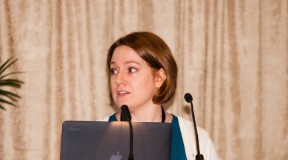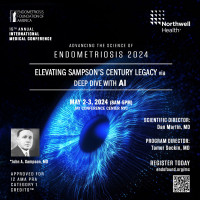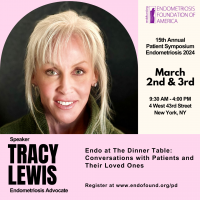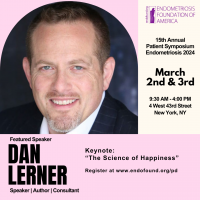Endofound’s Sixth Annual Medical Conference: Ending Endometriosis Starts at the Beginning
Robert Taylor, for those of you who are not familiar with him is one of the most influential scientists of our time. He is the vice-chair of research in the Department of Obstetrics and Gynecology at Wake Forest School of Medicine. He is a board certified OBGYN and reproductive endocrinologist widely published in the areas of endometriosis, embryonic implantation and early pregnancy complications. Among others he serves on many international, national and state executive committees such as ABOG, NIH Reproductive Scientist Development Program, many NIH Women’s Reproductive Health Research boards and the California Institute for Regenerative medicine.
One of the things we are going to learn about today in this incredibly interesting and informative day are some natural therapeutics for endometriosis, and Dr. Taylor, thank you so much.
Thank you everyone, it is really an honor for me to be here and really a pleasure to talk with you. I will apologize a little bit in advance. I am a scientist and a physician, and because I am a scientist that means I work for all of you. My job is to actually try to advance where medicine is these days. There is going to be a little science here but hopefully you will able to follow some of these things that I have been interested in over the past several years.
There are a lot of unmet needs as Deborah has already alluded to in this field of endometriosis. You have heard a lot about and will hear much more about laparoscopy during the whole course of the presentation. It plays an incredibly important role in how we manage the disease. We can see the abdomen beautifully and she showed you some wonderful photographs of that. We can biopsy or remove lesions. Ideally, excise those lesions through the laparoscope. But it does require a lot of surgical skill as there is risk associated with the surgery. Perhaps one of the most important problems, and this is looking at the data in general not in the hands of the best surgeons in the country, but if we take all gynecologic surgeons there is probably a 20 percent recurrence risk of the treatment of endometriosis. This really gives us an opportunity to think about how could we use medical therapies to augment the advantages we can get from our surgical approaches.
These were some pictures that I pinched from Deborah’s website actually. I thought that this was really lovely and she did a much better job of the Maori at the bottom there than I would be able to do. But I think as I have spent approaching 40 years in the field of gynecology I have been more and more troubled I think by the issues that are associated with adolescents with endometriosis. I think that this is an area in which we really want to look for the safest, best tolerated kinds of medical therapies that we can possibly find. These women, young women, who are focused now on their menstrual health and endometriosis, the ME Program, that Deborah has described to you, what I think is sad about some women that present with endometriosis at this time is that it is not uncommon, and Deborah gave even a more dramatic example of a 25 year old who had had almost 20 surgeries, but to see patients in our practices that have had multiple surgical procedures is really an issue that I think we can try to think about. As Deborah mentioned one or two very effective excisional surgeries are what we really want to try to provide but beyond that then we want to think about what sorts of medical therapies can we add to that that would maybe help prevent recurrence or the progression of this disease.
As a reproductive endocrinologist I can tell you that our approach, and I mentioned a little bit when Deborah called me up unprepared to comment about medical therapies, the approach we have taken really focuses on this reproductive axis that we, as reproductive endocrinologists, think about every day and this is really this whole pathway. It does not project so well but the brain, the hypothalamus part of the brain that regulates the pituitary gland, the ovaries, the uterus, this really central axis of hormone regulation is really how we have approached medical treatment of endometriosis. I have implied this. The endometrium, this is a cartoon really of the normal uterine endometrium, but we believe that endometriosis responds in very similar patterns through the cycle. This is the 28 days menstrual cycle. This grows and sloughs and grows and sloughs every cycle with your period. It is driven by a very complex regulation of hormones that sort of come down this reproductive axis. Almost all the treatments we have developed and evolved over the years have focused on this.
As you are aware we often use contraceptive pills initially, typically, in a cyclical fashion and then often continuously to try to suppress this as a medical treatment. GnRH analogues, drugs like Leuprolide acetate that also can inhibit this axis have been a common medical treatment. I am not going to talk about selective progesterone receptor modulators. These are drugs that might be coming onto the market in the future for this but might be interesting and have probably more of an effect on lesions themselves. The levonorgestrel intrauterine system that Deborah mentioned, these IUDs actually can be quite effective, medicated IUDs can be quite effective. Aromatase inhibitors, not FDA approved drugs, but they have shown to be quite beneficial but dramatically suppress estrogen levels so that women will experience menopausal kinds of symptoms, hot flashes, vaginal dryness, etc. Non-steroidal anti-inflammatory drugs, you are familiar with those. They probably have effects broadly; both in the brain on the pain fibers, the pain pathways that Deborah was talking about but also may be more directly on inflammation in the pelvis. As she mentioned we probably have to remember that narcotics still have a place but they are quite dangerous medications to use. Then there have been some things historically, Danazol, medroxyprogesterone acetate and selective estrogen receptor modulators. I am going to talk a little bit about those drugs on Monday in my second presentation. This is what is available and it all has a similar target.
This is quite a complicated, convoluted slide. I think you are all familiar with the idea that there is immune cell activation and immune cell effects on this problem of endometriosis. We have been working and trying to understand a little bit the nuances of this, which are fairly complicated. It is not important to know any of the details here but we think there may be classes of drugs and compounds that might target this immune or inflammatory part of the system. All of the medicines up until now have pretty much targeted the endocrinology axis trying to suppress estrogen production from the ovaries. We are hoping that there is going to be a new paradigm where we can actually develop drugs or compounds or use natural products, which I am going to talk about today that would actually target more of this inflammatory process. It might allow women to have normal cycles and at the same time suppress some of the inflammatory mediators the causes of the pain and potentially infertility. So, pain and infertility are the two targets. We think that these immune cells might be a way of getting to that problem without shutting down the whole hormonal axis.
What about natural products? For over 3,000 years we have been using herb derived compounds to try to treat inflammatory disorders, why not think about doing this in the setting of endometriosis? That is what I wanted to brief you about a little bit this morning.
This is a very complicated slide and it is not important that you see it at all but what it is is a recent paper looking at the effects of complimentary medicine therapies using traditional Chinese herbs in infertility treatment. There is not a lot of rigorous scientific data looking at some of these but this is the best compilation to date. I would say unfortunately for us is that there is a small beneficial effect, things that fall to the right side of that line would suggest that these treatments are sort of beneficial relative to no treatments at all. There is a small beneficial effect but unfortunately there are only two studies that really are focused on endometriosis. This is an infertility wide examination but now they have studied more than 4,000 women in fairly well controlled studies looking at herbs versus no medication, placebo or herbs versus some standard therapies. It does look promising I would say for the future but there is not very much information about endometriosis and infertility.
I think where we have more of our hope is in the treatment of pain. And probably, in my view, it would be the adjunctive treatment of pain symptoms following surgical excision. That is a little bit of the philosophy about where we are trying to go with this. This is just to remind me that we do not have very much information about endometriosis. This is really looking at infertility in general and as I think you all are aware there are many, many causes for infertility from the male factor, which treating women is not likely to benefit that to all other kinds of ovulatory dysfunction and polycystic ovaries and things like that that make this more complicated to think about.
As I mentioned, a lot of these herbs and spices that we use in our foods have also been traditional medical therapies for many years. I have been working with a group of herbalists actually in the Berkley area over the past several years and we have tried to come up with our nine secret herbs and spices and they are listed here as an approach to try to understand how we might think about treating endometriosis and endometriosis symptoms with traditional Chinese herbal types of therapies.
This is not an endorsement but these are our collaborators in Berkley at a place called Health Concerns. They actually put together this herbal combination that we have had the opportunity to study in a couple of laboratory models that I will try to describe to you a little bit, just to give you an idea about what kinds of things might be available, might evolve in future for the treatment, maybe a safe and well tolerated treatment, for some of the symptoms associated with endometriosis.
Again, I apologize. There is going to be a little bit of science here but I will try to make it as painless as possible. One of the approaches that we have used is to actually grow cells that we get from endometriosis tissue. In collaboration with all of the wonderful surgeons you will get to meet we actually get tissues from the operating room when an endometriotic lesion is removed. This is an ovary with an endometriotic cyst in it. We can actually remove the tissue and from that tissue we can actually culture and grow cells in a laboratory. This is what the cells cultures look like. Those are really very convenient models these are actually normal cells from normal women, so they are chromosomally normal. Many cell lines, cancer cells, things like that that are available in the laboratory really are not chromosomally normal, they are cancers. They are not representative of what goes on. We believe that these cells, because they are really derived from the endometriosis lesion, actually are quite representative of the cells in the body. They are very responsive to hormones. They will grow nicely. They are actually responsive to some of the contaminants and pollutants in our environment as well. Things like dioxin and Bisphenol A, which bind to a receptor, the Aryl hydrocarbon receptor, which is actually expressed in these cells just like it is in the normal setting. They make a lot of the inflammatory factors. Factors that stimulate nerves and blood vessels and lymphatics, I am going to talk a little bit about those, again, on Monday. What is nice is that we can treat these in the laboratory without subjecting any people, young women, to experimental drugs. We can actually treat in the laboratory and see how those respond.
This is just an example of cell growth in response to some different therapies. This is really just a marker of how rapidly the cells are replicating, how much they are growing potentially, we believe, representative of how an endometriosis lesion would actually grow and progress. Tumor necrosis factor alpha and inflammatory protein actually stimulates the cells to grow a little bit. You can see this is an increase. This is an important factor in endometriosis in vivo. Medroxyprogesterone acetate non-steroidal anti-inflammatories and an herbal extract, a tea essentially, that we make from these Chinese herbs all have the ability to suppress, to some extent, the growth of these endometriotic cells in the laboratory.
When we look at the cells under the microscope they actually look pretty healthy and normal even though they are not growing very well. But if we actually look at a specific type of staining you can see that in the control conditions where they are not exposed to herbs the cells do not show any of this green. This is actually DNA that is being decomposed through a process of programmed cell death. These herbs are actually causing the endometriosis cells to begin to undergo a cell death pathway, which is referred to as apoptosis. This is actually a Greek word that describes the falling of leaves from trees. Like in the fall these cells are actually lost or sloughed through a natural process of cell death, programmed cell death. We understand a little bit about the biochemistry of that and how the DNA is broken up. It is not important to understand those details but just to know that actually normal tissues grow and die typically in a cyclical fashion and we might be able to enhance the death of endometriosis tissues and cells by activating some of these pathways.
We do know that in normal women this process of cell death actually occurs in the endometrium at the end of the cycle, at the end of the menstrual cycle. This is what partly allows you to slough the normal endometrium. In women of endometriosis there seems to be a defect in that cell death pathway. I have cartooned it here, typically at the end of your cycle endometrial cells undergo this process of apoptosis and cell death and endometriosis this appears to be kind of initiated but it does not go through the whole process of killing the cells so they remain viable and they are able to grow in conditions outside of the uterus for example where they normally would not be able to grow. We are hoping that we can figure out how to enhance this pathway to get sort of a normal form of cell death. It sounds a little contrary but this would actually be part of the normal physiology.
One of the ways of trying to demonstrate this was to develop animal models to test these compounds. Rats do not normally get endometriosis. They do not have a menstrual cycle but we can create a kind of endometriosis by surgically removing some of the endometrium from the uterus of the rat and sewing it into the peritoneal cavity. This is how we would create this rat model of endometriosis. This is again showing you we can take the uterus endometrium and put it in the peritoneal cavity. After a month we start to get these lesions that grow. They do not look very much like typical human endometriosis lesions. You can see actually this is the little suture the blue suture material is where we sewed that little piece of endometrium into the rat’s peritoneum. These rats are then treated for a month with just saline. Here they are given a tea essentially of these herbs or given a subcutaneous injection under the skin of Leuprolide. With Leuprolide you can see that there is actually a regression of the lesion, you can see the stitches here but there is really no cystic lesion left and similarly with the herbs. We think that these might be potentially fairly effective compounds. This is in a rat endometriosis model.
I am also going to mention a little bit about curcumin. Turmeric has been used on the Asian subcontinent for thousands of years as a medicinal compound. It comes from the curcumin root which is ground up to make curry powders. We believe that there are a whole bunch of different chemical compounds within that but the compound curcumin, which is this polyphenolic organic molecule, we believe is the active component in curcumin for these medicinal products.
If we use those endometriosis cells that I showed you before and ask what are the effects of curcumin in the laboratory, you do not have to look at all of these and I probably should have just shown one or two but normal cells make a little bit of these inflammatory cytokines in the laboratory. Endometriosis cells make a lot of these inflammatory cytokines. When we add curcumin to it those cytokines are all inhibited. With the exception of one curious thing and that is interleukin 12, which is an anti-inflammatory protein. It is a protein that normally reduces inflammation. When we add curcumin that protein is actually increased. It suggests that curcumin not only inhibits the bad guys but it also stimulates things that actually might be helpful to resolve some of these.
The problem with curcumin is that it is very poorly absorbed when we eat it in our foods. You can taste it, it has a lot of flavor. It gets into our gastrointestinal tract but it is not very well absorbed because of the nature of the molecule. Working with some chemists at Emory University we have been trying to design chemicals that actually have much better drug-like abilities than natural curcumin through some fairly complicated chemistry that I really do not understand particularly well myself. These are some of the groups that are on the natural curcumin compound that have been modeled by trying to change the chemical structure. The idea is to try to improve the potency as well as the pharmacokinetics, the ability of that drug to really be absorbed and to get to different tissues within the body. Because if you eat it and it passes through you will affect some cells but not cells like endometriotic lesions that might be within the peritoneal cavity.
This is a little bit of a cartoon to show you a bit about how we are thinking about this and it gets into a protein called Nuclear Factor Kappa B (NF-kB), which is a very important massed regulator of inflammation. Under control conditions, and these are some pictures of some endometrial cancer cells actually but they are fairly representative, most of this protein, which is labeled green here lives out in the cytoplasm of the cell. The nucleus, the central part of the cell, is black and you can see what looks like holes in these cells. When we treat with an inflammatory cytokine those proteins rush into the nucleus and that is kind of shown in this cartoon, so the green in the cytoplasm now gets concentrated into the central nucleus. Here you can see these little spots are a lot smaller than the distribution here. If we treat cells with tumor necrosis factor alpha like here and then add increasing amounts of curcumin or, in this case our synthetic version of curcumin, you can see that the nuclear localization of these green proteins is actually reversed so that it looks like there is no inflammatory stimulus. By increasing the amount of this we can actually prevent this inflammatory activation. This is just a way of demonstrating the potency. Curcumin looks like this it inhibits the nuclear localization here. This EF-24 compound, our synthetic curcumin, is about ten times more potent chemically. That is the idea of these experiments.
We can do similar things with endometriosis cells, the ones that I showed you in the green picture a few slides ago. These are what the cells look like in the dish. This is that same tunnel staining, that green staining that I showed you when cells are induced undergo a programmed type of cell death, they turn green like this. You can see that curcumin and this EF-24 compound actually both cause a lot more cells to turn green. This is another example of a protein that is induced with a cell death and this is kind of the converse, this is actually a growth promoting nuclear factor that actually goes down with curcumin and EF-24. These are working conversely to show that the cells are being induced to die by curcumin, natural curcumin and also this synthetic version of curcumin, It is a little bit more potent.
To summarize, we think that this Nuclear Factor Kappa B inflammatory mediator is really critical to endometriosis growth. It causes immune cells to be recruited and activated, it causes blood vessels to grow, which allows the lesions to become vascularized and brings them nutrients so that they can actually grow. It actually causes the cells to be relatively immortal so that they do not die when they are supposed to. It causes the cells to stick to the peritoneal cavity and to sort of proliferate, to invade deeply and attract nerves and things like that that would stimulate pain. Again, the cells proliferate and survive under conditions that typically normal cells would not. We believe that herbs have compounds within them and ideally, maybe things that we could turn into more potent drugs that can block these kinds of pathways and actually inhibit this process. These sorts of drugs might be safer and better tolerated than things that inhibit ovarian hormone production, particularly in young women who may be looking at many years of being treated for a chronic disease that is going to continue, women who potentially have not been completely cured with excisional surgery.
To summarize, endometriosis can be effectively treated by surgical excision, but complications of surgery and rarely recurrence can occur, probably related to how effective the original surgery was in the first place. But I think we have to accept that in the real world there are a lot of cases that are inadequately treated.
Medical blockade of the hypothalamic-pituitary-ovarian axis, this hormonal axis, alleviates pain symptoms but is associated with Hypoestrogenic or menopausal kinds of side effects that can be quite severe and I think most of you are familiar with those.
The side-effects might be particularly bad in young women who are looking at many, many years of treatment.
We believe that immune cell activation and inflammation are really important contributors also to this process. And that maybe these natural herbal compounds, including curcumin, can inhibit this process by inhibiting this NF-kB protein inducing the cells to undergo programmed cell death and be shed and be gotten rid of the way it probably occurs in normal women.
It is possible that we can maybe improve on mother-nature a little bit in terms of developing synthetic versions of these natural compounds that might have better drug-like characteristics and capabilities. They could be put into pills. You could keep them on the shelf you would not really have to be brewing teas and things like that.
This part of it I will admit the naturopathic/herbalist that I interact with are not so excited about our going in this direction. But I think it is something to think about in terms of the future.
There have been a lot of people who have contributed to these studies, particularly Misha Cohen and Andrew Gaeddert in Berkley who actually introduced us to their compounds that we have been able to use in these pre-clinical models to look at ways of trying to understand how these types of therapies might be used.
Thanks so much for your attention and I look forward to the question and answer period at the end.
Thank you very much. Lone, you have definitely put together a stellar line up. We have about five to seven minutes, emphasis on closer to five for questions for Dr. Taylor. If you just want to raise your hand I will come to you.
Audience Member: Could you please explain the acronyms that you talked about as far as with the hormone regulation, the OCP, GnRH, SPRMs, LNG-IUS, ALS, yes!
Robert Taylor, MD: Sorry about that. Oral contraceptive pills, so these are birth control pills. The GnRH analogues would be like Leuprolide, these are typically subcutaneous injections, skin injections and sometimes long acting drugs that actually inhibit the pituitary hormone production that are used, Lupron would be an example of this kind of drug, used in endometriosis therapy. These drugs, the SPRMs I should not really talk about because they are not clinically available yet but they are things that we hope are going to come along the way to be beneficial. This is the Levonorgestrel intrauterine device, the Mirena device, which is an IUD that actually has a progestin compound levonorgestrel in it. It sort of seeps out of the device and actually gives you local hormone treatment within the pelvis. Aromatase inhibitors – these are drugs that are actually used in breast cancer therapy quite a bit. They block the ability of cells to make estrogen, so they reduce the amount of estrogen that is around, so have similar effects to some of these other compounds. Non-steroidal anti-inflammatory drugs would be like Naproxen or Advil, which actually have anti-inflammatory effects and probably broad effects and probably have some central effects on the brain too in terms of pain perception and that is why they work well for headaches and kind of general types of pain. Opiates would be narcotics and these have, as far as we know, purely kind of a central effect and obviously they have abuse potential and things like that. Danazol, hopefully maybe people have never heard of Danazol but Danazol is a testosterone derivative that we used to use a lot in 1970s and a little bit into the 1980s and associated with quite a bit of bad side effects, acne, weight gain, oily skin, increased muscle mass, decreased breast size. I had an opera singer in San Francisco who was treated with that and it permanently changed her vocal range. It is still available and it can be used in some settings. Medroxyprogesterone acetate, Provera, Depo-Provera – sorry about that, but thanks for the question.
Moderator: Thank you.
Audience Member: Thanks Dr. Taylor for your great work on finding out, or helping to find out the mechanism of the disease. That is really interesting. Just speaking from a patient perspective I also think looking at non-hormonal treatments would be beneficial not only to young women who are looking at years of hormonal treatment otherwise, but to other types of patients who have other medical conditions for which they cannot take hormonal treatment, like cardiac conditions or what have you that are outside what is going on with the endo – so it is great work.
Robert Taylor, MD: Thanks. When Deb asked me the question a little bit about medical therapy one of the problems with all of these treatments that are shown there on the left they all basically work by inhibiting ovulation. So in women who are actually trying to treat endometriosis symptoms and get pregnant at the same time, these things really shut that down entirely. One of the thoughts about these herbal or more inflammatory mediated pathways, away from the hormone pathways, is that it might be possible for women to take these medications and still have normal ovulatory function. And if the medicines do not have ill effects on fetal development and things like that and all that would have to be worked out, it might be possible to actually conceive while taking some of these medications. So that would be an advantage that we do not currently have.
Audience Member: Good morning, I have a question. I had my first period when I was nine. All my aunts they had everything removed when they were 35/36. Now, my niece is five is there any connection to, like you pass it on by your women in your family? That is the first thing, what should we do for our young generation that is coming forward?
Robert Taylor, MD: We do know there is a genetic component to endometriosis and that in families there is probably a six to eight fold risk with a history like you have of other girls and young women in your family relative to the rest of the population being likely to develop endometriosis. I think that having knowledge about the disorder and awareness of it is really the most important thing and informing your sisters and your niece, when it is age appropriate. And watching her develop and when she goes through puberty trying to assess what the nature of her periods are like because early intervention can be extremely important, and maybe even prevention. Some of these things like herbs that would be very safe to take we might want to actually use as a preventative therapy to really prevent endometriosis lesions from ever really getting established. I think that the best thing is communication and information.
Moderator: Thank you. We have time for one more after this.
Audience Member: Good morning, I wanted to ask you about endometriosis being, I do not know, described as an uncontrolled growth of cells. Why is it not characterized as a cancer and why do women have such a hard time getting proper pain management for it because doctors do not think it really, really hurts?
Robert Taylor, MD: Yes, those are great questions and I am afraid that the second question I think again it is going to be a question of information and we have to educate other physicians including those really within our own specialty as to how we need to be aggressive about treating these problems. Endometriosis is typically defined as a benign disease, which I think is really a misnomer. Benign means that it is sort of good actually as opposed to malignant. Endometriosis can essentially metastasize it can go to distant sites. It has a lot of characteristics that are similar to cancer. It is fortunately the chromosomal nature of endometriosis as such that there are subtle changes, enough to cause great disturbance and a lot of pain but not enough to actually cause the cells to typically, except for in rare instances, to undergo malignant transformation where they really could be considered cancers. There are a couple of types of ovarian cancers that are associated with endometriosis. Fortunately, those are rare. It is really more of a technicality that we do not call it a cancer but I think that it is important to remember that it has lots of characteristics that cause a lot of symptoms. But fortunately for us I think in terms of treatment options it is not really a truly malignant condition. It is not truly a cancerous condition. But you are right, it is a little grey.
Moderator: Just as a reminder if we do not get to your questions now there will be a Q&A later today. Last question.
Audience Member: Hi there, I actually just wanted to say thank you. I had early diagnosis, I had the beautiful excision surgery and my pain remained and grew, so definitely fit within Deborah’s story here. But I wanted to say thank you for your research because traditional Chinese medicine and herbs were a huge part of my recovery. So I am just very happy that there is somebody bridging the gap between eastern medicine and western medicine, thank you.
Robert Taylor, MD: Thanks, actually Deborah did imply that even after removing the disease if there has been a pain loop activated that that can persist and it can be stimulated by other kinds of stimuli as well, even if the endometriosis is gone. Some of these anti-inflammatory drugs probably have central effects that might be beneficial in that.










